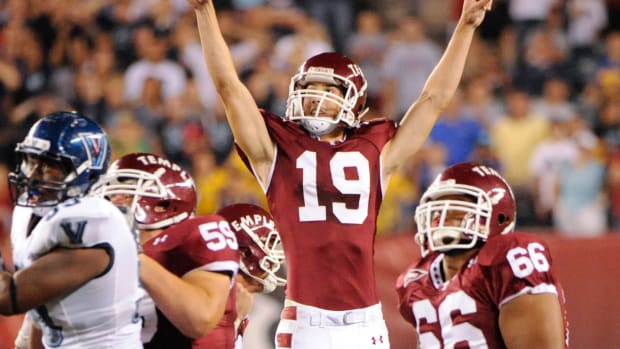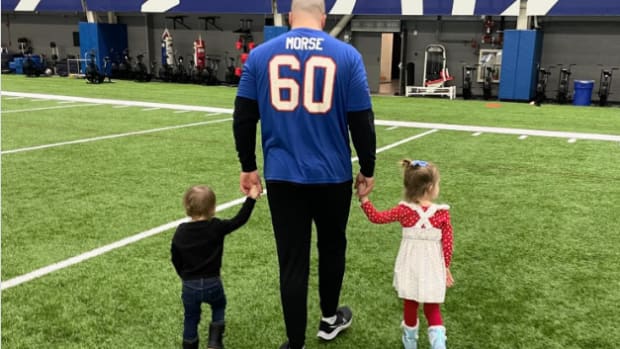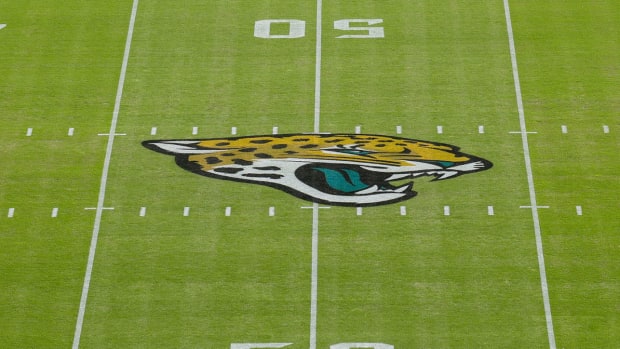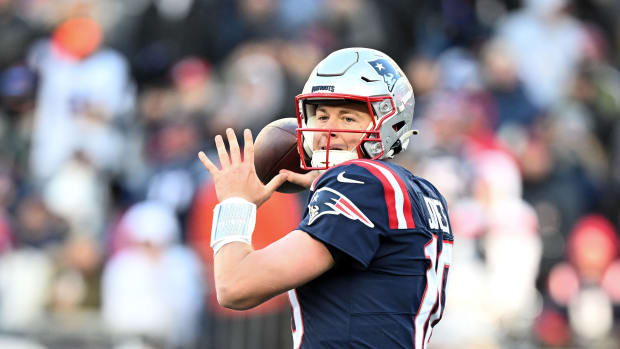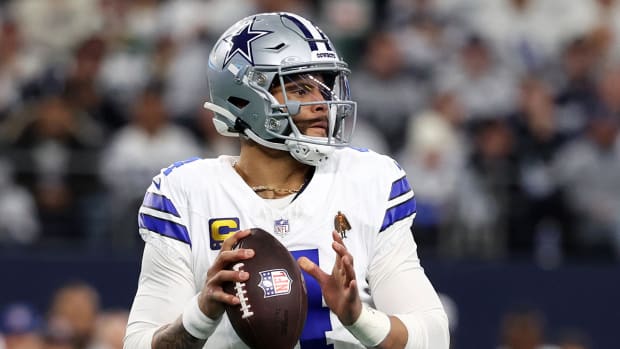NFL Draft: How Did the Jaguars' AFC South Rivals Fare During the 2021 Draft?
When it comes to the offseason, all 32 NFL franchises have one goal in mind: getting better in hopes of competition for the Lombardi Trophy next season. But to get a chance to reach the NFL's mountain top, each team first has to duke it out within their own division.
There is no clearer path to playing meaningful games in January than for a team to consistently have success playing within its own division; teams throughout the league build themselves specifically to win those divisional battles considering that is the easiest way to make the playoffs.
With this in mind, how did the Jaguars' AFC South rivals draft last week? We know all about the nine-player class the Jaguars added, but what did their rivals do throughout the draft? We examine the Colts', Titans', and Texans' classes here.
Indianapolis Colts
- Round 1, No. 21: DE Kwity Paye, Michigan: While Kwity Paye never had a season at Michigan with more than 6.5 sacks (and only had more than 2.0 sacks once in four seasons), but he is the most naturally-gifted edge rusher in the 2021 draft class. The Colts will likely allow Paye to pin his ears back and attack upfield much more than Michigan did, so it is hard to say this wasn't a home run selection at No. 21 overall for a team that badly needed a No. 1 pass-rusher.
- Round 2, No. 54: DE Dayo Odeyingbo, Vanderbilt: If the Kwity Paye pick was a home run, the selection of Vanderbilt defensive lineman Dayo Odeyingbo is more like a steal attempt at the home plate. The potential reward is high due to his size and versatility as an inside/outside pass-rusher, but the risk runs just as high due to his January achilies tear.
- Round 4, No. 127: TE Kylen Granson, SMU: This was a strange selection to me. Kylen Granson is a natural receiver at the tight end position due to his smoothness as a route runner and safe hands, but he is already one of the NFL's smallest tight ends at 6-foot-1 and 241 pounds. Taking an undersized pass-catching tight end this highly seemed strange for a team that needed help at offensive tackle and wide receiver.
- Round 5, No. 165: S Shawn Davis, Florida: This seems like the perfect Colts' Day 3 selection. Shawn Davis is tough, physical, and is willing to be a tone-setter in the back-end of a defense. He fits the Colts' scheme well and his athleticism and play-making ability could help him outplay his draft slot.
- Round 6, No. 218: QB Sam Ehlinger, Texas: Burning Day 3 picks on quarterbacks can work out (Gardner Minshew is a recent example), but in most cases it represents failing to get the proper value out of an asset. The best way for Sam Ehlinger to justify this selection would be for him to win the backup job behind Carson Wentz, but the Colts just drafted Jake Fromm in the fourth round in 2020.
- Round 7, No. 229: WR Mike Strachan, Charleston: An intriguing height/weight/speed project, Mike Strachan had to wait far too long to hear his name called, in my opinion. He will clearly have to work on his technique and his ability to win on routes other than 'Go' routes, but his blend of size, speed, and ability to win with the ball in the air is rare.
- Round 7, No. 248: OT Will Fries, Penn State: Will Fries was considered a fringe draftable prospect by most publications, but he brings some versatility to the Colts' offensive line. He started 26 games at right tackle, nine at left tackle, six at right guard, and one at left guard.
Overall, the Colts had, in my opinion, the second-best first-round selection of the AFC South's four picks within the top-32 (Trevor Lawrence takes the top spot, clearly). After that, it is tough for me to love what they did. Dayo Odeyingbo is talented when healthy, but they passed up on a safer and potentially better prospect in Carlos Basham. Otherwise, the Colts added depth pieces and a pass-catching tight end whose size may restrict him to more of an H-Back role. They should still be among the favorites to win the division, but they didn't do much in the draft to improve the roster other than selecting Paye.
Houston Texans
- Round 3, No. 67: QB Davis Mills, Stanford: The first pick made by the Texans in 2021 was on a quarterback, which could be telling for how the franchise plans to play out the 2021 season. One has to think the Texans envision Mills as a quarterback who will play as a rookie, but that is asking for a lot from a passer who threw just 438 passes in college and is streaky as a decision-maker.
- Round 3, No. 89: WR Nico Collins, Michigan: On the surface, there is nothing wrong with Houston picking Nico Collins. He is a high-upside pick and is one of the few 'X' receivers in this class after the first two rounds who has the ability to beat defenses vertically. With this in mind, it is hard to wrap one's head around the deal the Texans made to move up to get him. Houston traded the 109th overall pick and the 158th overall pick in Round 5 along with a 2022 fourth-rounder to the Carolina Panthers for the 89th overall pick. That seems a bit extreme for a raw receiver prospect, especially when it comes to a team with limited draft resources.
- Round 5, No. 147: TE Brevin Jordan, Miami: There are enough questions around Brevin Jordan's game (lack of length, timed speed, natural hands) to justify him dropping this far, but the Texans also drafted the best tight end prospect out of each AFC South team despite picking theirs last, selecting Brevin Jordan after Granson and Luke Farrell went off the board to the Colts and Jaguars.
- Round 5, No. 170: LB Garret Wallow, TCU: Another trade up target, Houston sent picks 203 and 212 to Buffalo to select Garrett Wallow. Wallow is a solid athlete (4.12 short-shuttle), but he weights just 220 pounds and has limited upside against the run despite that being his strong suit at TCU.
- Round 6, No. 195: DT Roy Lopez, Arizona: An athletic, up-field penetrator, there is no real reason to poke any holes in the selection of Roy Lopez here. He isn't Marvin Wilson, but he is a fair pick at No. 195 overall.
It is tough for me to see the vision with Houston's selections. None of their picks really move the needle, while the two trade ups they made were for players one wouldn't think would necessitate such moves up the board. Houston was never going to have a strong draft class due to their lack of draft capital, but this feels underhwelming even within that context. I think Jordan could develop into a solid No. 2 tight end, but the odds of Mills overcoming his decision-making and consistency issues on one of the NFL's worst rosters seems low.
Tennessee Titans
- Round 1, No. 22: CB Caleb Farley, Virginia Tech: One of my favorite defenders in the draft, the questions with Caleb Farley are clear. If he remains healthy, he has the upside of a Pro Bowl or even All-Pro cornerback. Had there been no durability concerns, there is a good chance Farley is one of the first two cornerbacks drafted and goes in the top-10. This is the ultimate risk/reward type selection.
- Round 2, No. 53: OT Dillon Radunz, North Dakota State: After the Titans swung and missed on Isaiah Wilson as their long-term right tackle in 2020, they went the small school route and took Dillon Radunz after players like Walker Little, Jackson Carman, and Samuel Cosmi came off the board. Radunz has a lot of natural talent thanks to his smooth pass-sets, quick feet, and explosive get-off, but he does need to add a good bit of play strength to handle power rushers at the next level.
- Round 3, No. 92: LB Monty Rice, Georgia: An explosive straight-line athlete, Monty Rice is undersized but has a considerable amount of production and experience in the middle of Georgia's defense over the last several seasons. Still, this seems like a slight reach considering Baron Browning and Jabril Cox were still on the board.
- Round 3, No. 100: CB Elijah Molden, Washington: One of the best value picks of Day 2, Elijah Molden is undersized and didn't test like a particularly explosive or twitched-up athlete, but he was one of the best nickel defenders in all of college football in recent seasons. He just seems like the type of player who could thrive in the slot for years to years to come, and his physical play style fits the Titans' defense well.
- Round 4, No. 109: WR Dez Fitzpatrick, Louisville: A former four-star recruit and a four-year starter at Louisville, Dez Fitzpatrick may not present a ton of upside in terms of physical traits, but he is a relatively high-floor depth receiver option who could potentially serve as a No. 3 wide out early on in his career.
- Round 4. No. 135: DE Rashad Weaver, Pittsburgh: Just days following the draft, Rashad Weaver was charged by the Pittsburgh Police Department with simple assault of a woman. "We were made aware of this news this morning," the Titans said in a statement. "We obviously take this seriously and are in the process of gathering details and working with the league."
- Round 6, No. 205: WR Racey McMath, LSU: On one hand, Racey McMath ran the 40-yard dash at a 4.39 speed at 6-foot-2, 212 pounds. On the other hand, he caught just 33 passes for 522 yards and four touchdowns during his LSU career, so there is a strong chance he may max out as a key special teams player.
- Round 6, No. 215: S Brady Breeze, Oregon: The Rose Bowl MVP in 2019, Brady Breeze didn't play in 2020 after opting out. With this in mind, he likely would have been drafted even higher than this had he played last fall. As of now, he is good special teams depth and a backup safety worth developing.
Overall, the Titans went all in on upside with their first three picks and then took mostly high-floor defenders and special teams prospects after that. If Farley hits and Radunz turns into a long-term starting right tackle, then this will be a solid draft class. Still, those are two pretty big rolls of the dice for a franchise that lost a lot of talent this offseason.
